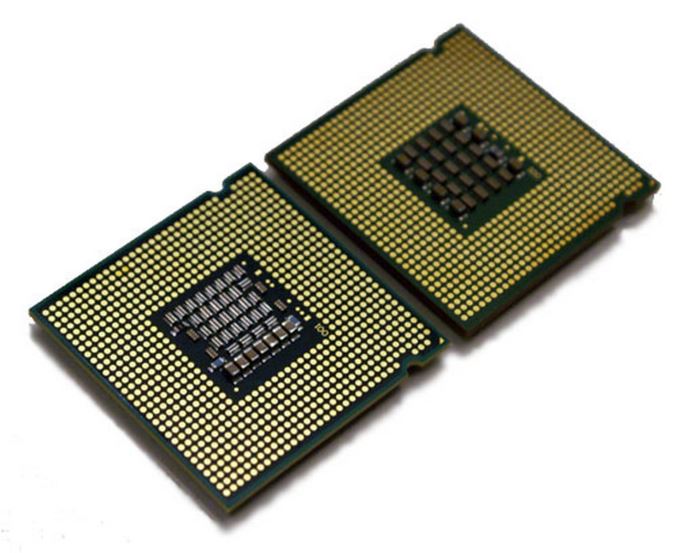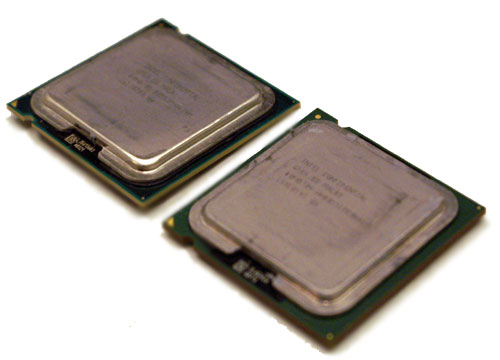Ten Year Anniversary of Core 2 Duo and Conroe: Moore’s Law is Dead, Long Live Moore’s Law
by Ian Cutress on July 27, 2016 10:30 AM EST- Posted in
- CPUs
- Intel
- Core 2 Duo
- Conroe
- ITRS
- Nostalgia
- Time To Upgrade

Today marks a full 10 years since the first Core 2 Duo processors, and hence Intel’s 64-bit Core microarchitecture, were made officially available at retail. These included a number of popular dual-core processor parts, including the seemingly ubiquitous E6400 and the Core 2 Extreme X6800. These were built on Intel’s 65nm process, and marked a turning point in the desktop processor ecosystem. To quote Anand in our launch review: ‘you’re looking at the most impressive piece of silicon the world has ever seen’.
Ten Year Anniversary of Core 2 Duo and Conroe
As part of this piece we will also look at some of the predictions for the future, from the latest (and possibly last) International Technology Roadmap for Semiconductors report, which predicts the stalling of smaller silicon manufacturing nodes over the next 10-15 years.
The first part of this article borrows heavily from Johan’s original look into the Intel Core microarchitecture back in 2006. It’s an awesome read.
Back When I Were A Lad
For a number of our readers, the launch of Conroe was a vast change in the processing landscape. The family of Netburst, Northwood and Prescott processors, in the form of Pentium D and Pentium 4, showed that pursuing the frequency race pushed the silicon far outside its efficiency zone and left a hot, power hungry mess in its wake. It didn’t even come with a muscular V8 sound, and AMD’s Athlon 64 X2 line had taken both the performance and efficiency crown.

Core 2 Duo (left) vs Pentium D (right)
From the perspective of Intel, it had to incorporate a significant paradigm shift in the way it approached the core microarchitecture – no more long pipelines to bump up clock rates to start. The Core microarchitecture design was marketed as a blend of Pentium Pro and Pentium M techniques, as well as the Netburst architecture, however as Johan pointed out at the time, it is significantly Pentium M and it is very hard to find anything Netburst in there. It wasn’t as simple as ‘adding a few functional units or decoders on Yonah and calling it a day’, almost 80% of the architecture and circuit design had to be redone.
As part of this piece, we’re going to take another look at the original architecture improvements of the Core microarchitecture design and some of our old performance metrics from a decade ago.
27th July 2006: Core 2 Launch Day
Ten years ago, Intel launched the following five processors:
| CPU | Clock Speed | L2 Cache |
| Intel Core 2 Extreme X6800 | 2.93GHz | 4MB |
| Intel Core 2 Duo E6700 | 2.66GHz | 4MB |
| Intel Core 2 Duo E6600 | 2.40GHz | 4MB |
| Intel Core 2 Duo E6400 | 2.13GHz | 2MB |
| Intel Core 2 Duo E6300 | 1.86GHz | 2MB |
The X6800 sits at the top with a higher clock speed with a higher supported FSB-to-core ration than previous Intel processors. The Core 2 processors all came from a 143mm2 die, compared the 162mm2 of Pentium D, and they both seem tiny by comparison to the large die sizes we see 2016 for things like the P100. These were chips without integrated graphics either. The introduction of Core 2 pushed the prices of the Pentium D processors down, to give this interesting table:
| CPU | Clock Speed | L2 Cache | Price |
| Intel Core 2 Extreme X6800 | 2.93GHz | 4MB | $999 |
| Intel Core 2 Duo E6700 | 2.66GHz | 4MB | $530 |
| Intel Core 2 Duo E6600 | 2.40GHz | 4MB | $316 |
| Intel Core 2 Duo E6400 | 2.13GHz | 2MB | $224 |
| Intel Core 2 Duo E6300 | 1.86GHz | 2MB | $183 |
| Intel Pentium D 945 | 3.40GHz | 2MBx2 | $163 |
| Intel Pentium D 915 | 2.80GHz | 2MBx2 | $133 |
| Intel Pentium D 820 | 2.80GHz | 1MBx2 | $113 |
| Intel Pentium D 805 | 2.66GHz | 1MBx2 | $93 |
Comparing this to recent Intel processors, and the X8600 matches the list price of the Core i7-5960X (an 8-core part), whereas the popular Core 2 Duo E6400 at $224 at the same price as the Core i5-6600.
A few years ago, I salvaged a super old computer of mine with an E6400 and took it for a spin for a pipeline piece entitled ‘Dragging Core 2 Duo into 2013’. We know that a number of users today are still using the old platform as their day to day machine, and given that it is now celebrating its 10th birthday, it is interesting that anyone wanting to play around with the old hardware can get a motherboard, memory and CPU from eBay for $50-70.
My crusty C2D Setup from 2013











158 Comments
View All Comments
e1jones - Wednesday, July 27, 2016 - link
My E8400 is still my daily driver, 4x 2gb and an SSD swapped in later as the boot drive. Still runs great, except it tends to get bogged down by the TrustedInstaller and the Firefox memory leaks.rarson - Friday, August 5, 2016 - link
I've got an E8600 in an Abit IP35 Pro motherboard. I was having a hard time finding DDR2-1066 last I looked, so I settled for 800. With an SSD and 7870, it's surprising how well it still games. I don't think I'll upgrade the GPU again just due to the fact that I'm limited to PCI-e 2.FourEyedGeek - Monday, August 8, 2016 - link
You could get a higher end GPU and still benefit from increased performance, then get a new CPU motherboard combo when you want too.BrokenCrayons - Wednesday, July 27, 2016 - link
I just upgraded out of a Q6600 and 4GB DDR2 about 2 months ago and I admit that I was still kicking around the idea of leaving it alone as I was pulling the motherboard out of the case. I replaced it with a cheap AMD 860k and 16GB DDR3 which really hasn't done a lot to improve the system's performance. In retrospect, I think I could realistically have squeezed another couple of years out of it, but the motherboard's NIC was iffy and I really wanted reliable ethernet.As for laptops, I've got a couple C2Ds kicking around that are perfectly adequate (T2310 & P8400) for daily use. I really can't see any point in replacing them just yet. Core was a good design through all its iterations.
Beany2013 - Wednesday, July 27, 2016 - link
I like your style - rather than drop $100 on a midlevel intel NIC, you replace an entire platform.I strongly approve of these economics :-)
Michael Bay - Thursday, July 28, 2016 - link
USB3 is kind of nice.BrokenCrayons - Thursday, July 28, 2016 - link
Well the NIC wasn't the only reason, but it was the last in a series of others that I was already coping with that tipped the scales. The upgrade was under $200 for the board, processor and memory so it really boiled down to one weekend dinner out to a mid-range restaurant. It was worth it for more reliable Steam streaming and fewer VNC disconnects as that wired ethernet port is the only means by which I regularly interact with my desktop since it has no monitor and is crammed into a corner in my utility room.artk2219 - Friday, July 29, 2016 - link
Why didn't you go for an FX if you dont mind me asking? You liked the FM2+ platform a bit better?BrokenCrayons - Friday, July 29, 2016 - link
Actually, I didn't give much of anything in the system a very close look before buying. I admittedly did about twenty minutes of research to make sure the 860k and the bottom feeder motherboard I'd picked would play nicely together before making a purchase. So the CPU & motherboard pair were the result of laziness and apathy rather than a preference for FM2+.artk2219 - Monday, August 1, 2016 - link
Ah ok gotcha, I just wanted to share that if you had a microcenter near you they sell FX 8320E's bundled with motherboards for 125 to 170 depending on which board you want to use. That can be quite the steal and a great base for a new cheap system once you bump the clocks on the 8320E.